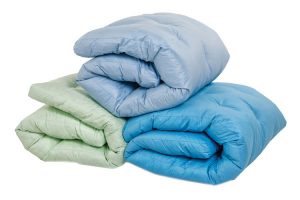Is there a way of determining whether a stain is oil-based or water-based before I launder the garment?
The only way you can determine that is by laundering both types of stains year after year. Visually, there is no way to tell the difference. Some water-based stains look like they’re oil-based, and vice versa. This is especially true when it comes to rust stains. Rust stains can have four or five different colors. They can be dark gray. Some are black. Some are yellow. Some are orange. All I can tell you is that experience will teach you.
My laundry is located in West Virginia, and I’m considering adding a rental segment to my business – renting work uniforms and washing them. I see a great opportunity for this in my area with all of the coal and oil workers that come into my store.
This type of business is often handled by those in either the commercial laundry or drycleaning businesses. However, that’s not to say it’s a bad idea, especially if these customers are coming to your coin laundry now anyway. Given that, you could probably develop a profitable new business segment, as long as you could actually get the garments clean.
If you’re anticipating tackling that kind of business, it’s crucial to have the proper equipment (large-capacity and programmable), the proper water temperature (hot… probably in the 140-degree range) and the proper chemicals – as well as finishing equipment so that you can service these accounts efficiently and neatly.
Obviously, before you go after any of this new business, be sure you thoroughly investigate it. For example, with the coal workers’ garments, you’ll be dealing with coal dust, which is extremely difficult to remove from fabrics and requires some specific washing procedures.
Again, it sounds like a possibly lucrative idea. But be certain that you know what you’re getting into before you pursue this type of business.
I am having trouble with very heavily soiled perspiration stains. I have tried ammonia and vinegar, but with little success. Do you have any ideas?
First of all, perspiration stains, if they are set in for a long period of time and in a consistent manner, are very difficult – and sometimes they cannot be removed at all. The acid and oil in perspiration can actually discolor the molecules in the fabric.
Your best bet is to purchase a gallon of spray spotter for drycleaners. Most laundry suppliers carry this product, which features the necessary chemicals to disburse most perspiration stains.
Typically, spray the spotter directly on the stain, and then run the garment through a normal wash cycle. If you are using bleach as well, use non-chlorine bleach.

We are trying to set our wash-dry-fold pricing and have noticed a big difference in how large items are priced. In our area, drycleaners and laundromats with wash-dry-fold services charge a per item fee for comforters, bedspreads, blankets and other large items – which is significantly higher than if they charged by the pound.
These larger items are easier to wash and dry, yet cleaners and laundromats charge a lot more to wash them. Are there additional reasons for this higher pricing besides “that’s what the market will bear?”
I can see why you think there might be a discrepancy in the pricing, but let’s look at these items more closely.
First of all, certain items like comforters, bedspreads and blankets, carry a higher value when the customer buys them. After all, many of them are made of expensive nylon and other costly materials. Therefore, there is more of a liability if you were to damage them.
Secondly, many of these items are bulky. For example, one pound of feathers could probably fill a 50-pound-capacity washing machine, even though it’s only one pound of feathers. It’s the same principle with comforters – a comforter might only weigh five pounds, but you’ll probably have to use a 30- to 50-pound machine to wash it.
Next, look at your drying time. The bulkier and fluffier the items, the more time it will take to dry them.
Lastly, the packaging requirements on these larger items are a little different, too. After all, you have to use hangers, plastics and special bags to hold them.
These are a few of the reasons for the higher prices.











